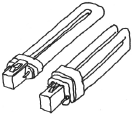What light bulbs should I look for?
Fluorescent tubes, when properly selected, offer you many advantages over common incandescent bulbs. You will not usually get burned by touching them, they spread light over large areas without excessive glare, and they last 10 to 20 times longer than incandescent bulbs so you will rarely have to replace them. On top of all that, they will reduce your electric bill since they use only 20 to 30% as much energy as incandescent bulbs for the same amount of light.
Current technology has overcome many problems associated with fluorescent tubes. You can now get fluorescent tubes with excellent color, plenty of light, and no buzz or flicker. To take advantage of the benefits of fluorescent lighting:
- Choose fixtures designed for fluorescent tubes.
- Request "T8 fluorescent tubes with an electronic ballast" when selecting fixtures that use the long fluorescent tubes (see What should I ask for to get good fluorescent lighting?).
- Use compact fluorescent bulbs that have a screw-in base to replace conventional incandescent light bulbs in your existing fixtures. Select a compact fluorescent bulb that is about 1/3 the wattage of your current incandescent bulb being replaced. Use compact fluorescent bulbs only where they fit completely within the fixture (see What should I ask for to get good fluorescent lighting?).
- Select frosted, not clear, incandescent bulbs.
- Consider using floor and table lamps designed for metal halide bulbs where you want a lot of light, such as beside your reading chair. Metal halide bulbs take several minutes to come up to brightness, but you will be rewarded with a lot of light, good color, and low electricity demand.
 |
 |
 |
 |
| A. | B. | C. | |
| Select fixtures designed to use what is termed "pin base" fluorescent bulbs
(a). The Energy Star label |
|||


